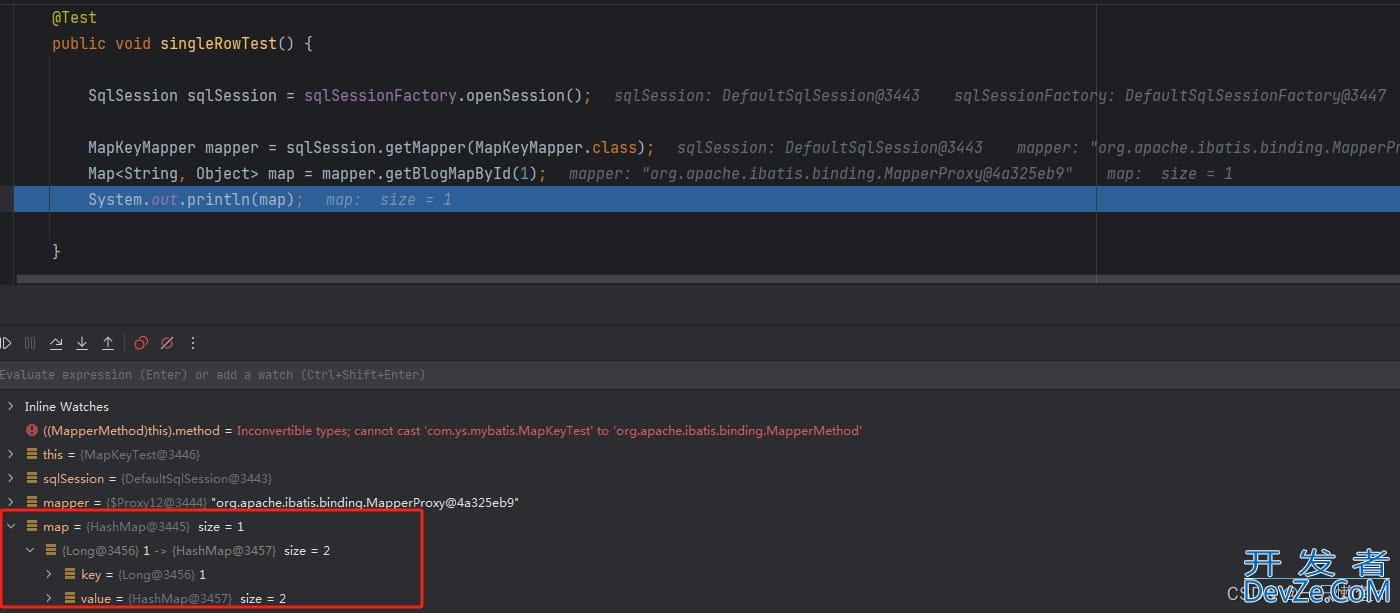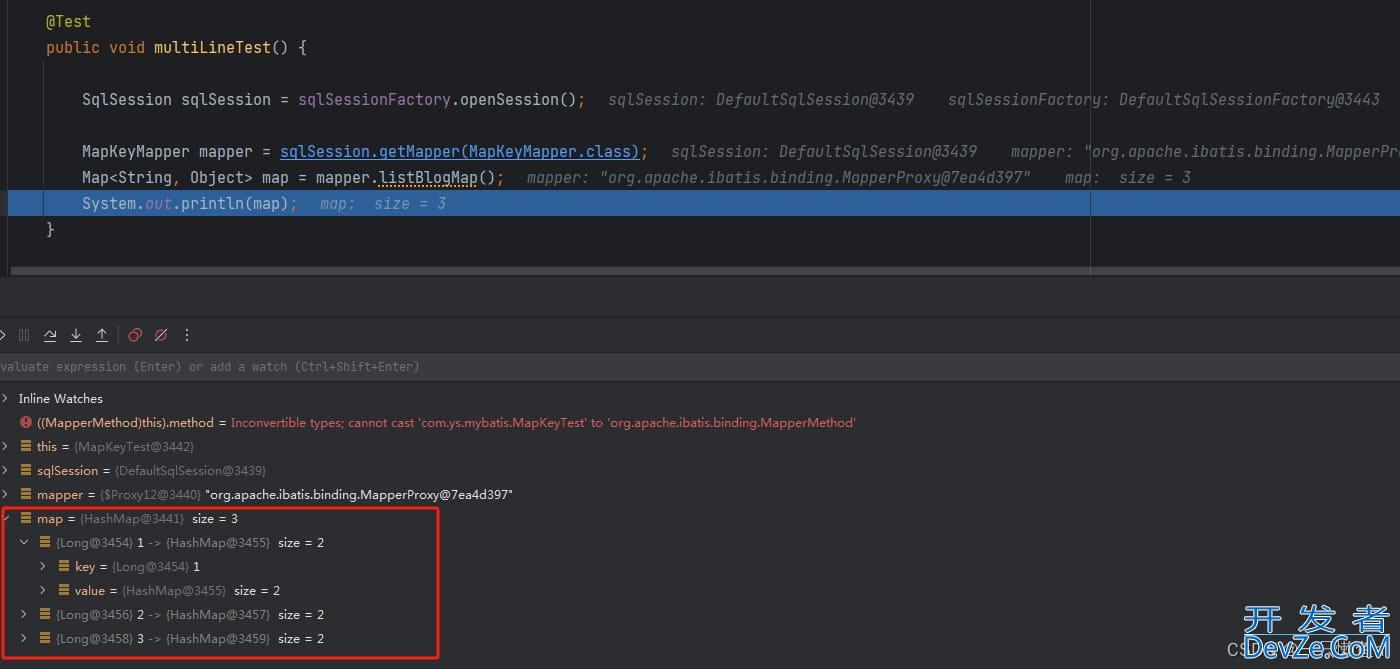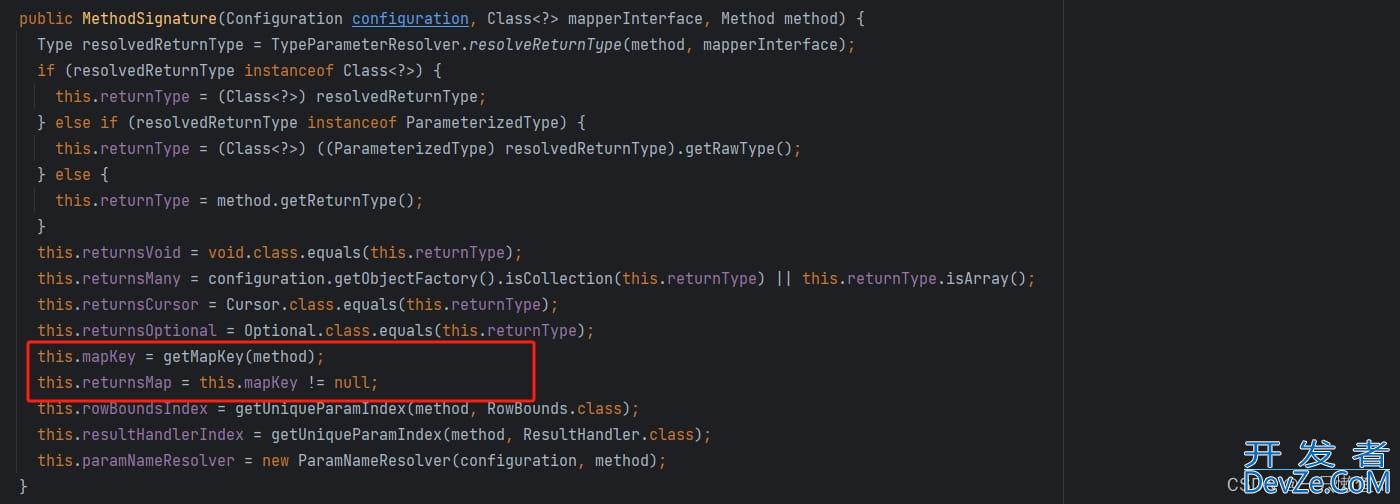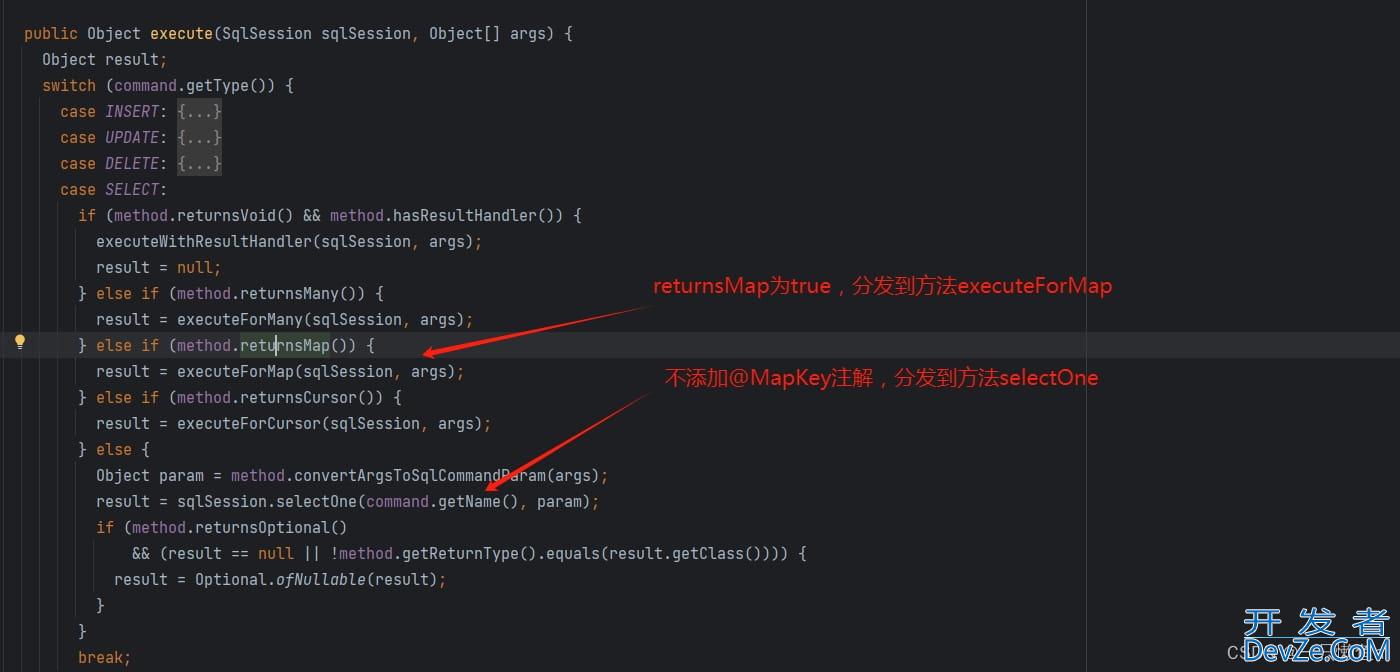目录
- 前言
- 案例演示
- 代码准备
- 创建myBATis-config.XML
- 创建MapKeyMapper.xml
- 创建接口MapKeyMapper
- 创建测试类MapKeyTest
- 单行不使用@MapKey注解
- 多行不使用@MapKey注解
- 单行使用@MapKey注解
- 多行使用@MapKey注解
- 源码解析
- selectOne
- selectMap
- DefaultMapResultHandler实例化
- handleResult
前言
演示返回单行、多行http://www.devze.com数据,使用@MapKey和不使用@MapKey注解的区别,然后通过源码解析产生各种结果的原因
案例演示
分别演示下列四种情况
- 单行不使用@MapKey注解
- 多行不使用@MapKey注解
- 单行使用@MapKey注解
- 多行使用@MapKey注解
代码准备
创建mybatis-config.xml
<?xml version="1.0" encoding="UTF-8" ?>
<!DOCTYPE configuration
PUBLIC "-//mybatis.org//DTD Config 3.0//EN"
"http://mybatis.org/dtd/mybatis-3-config.dtd">
<configuration>
<properties>
<property name="driver" value="com.mysql.cj.jdbc.Driver"/>
<property name="url" value="jdbc:mysql://127.0.0.1/test?useUnicode=true&characterEncoding=utf-8&useSSL=false&serverTimezone=Asia/Shanghai&allowpublicKeyRetrieval=true"/>
<property name="username" value="root"/>
<property name="password" value="123456"/>
</properties>
<settings>
<setting name="mapUnderscoreToCamelCase" value="true"/>
</settings>
<environments default="default">
<environment id="default">
<transactiojsnManager type="JDBC"/>
<dataSource type="POOLED">
<property name="driver" value="${driver}"/>
<property name="url" value="${url}"/>
<property name="username" value="${username}"/>
<property name="password" value="${password}"/>
</dataSource>
</environment>
</environments>
<mappers>
<mapper resource="mapper/MapKeyMapper.xml"/>
</mappers>
</configuration>
创建MapKeyMapper.xml
<?xml version="1.0" encoding="UTF-8"?>
<!DOCTYPE mapper PUBLIC "-//mybatis.org//DTD Mapper 3.0//EN" "http://mybatis.org/dtd/mybatis-3-mapper.dtd">
<mapper namespace="com.ys.mybatis.mapper.MapKeyMapper">
<select id="getBlogMapById" resultType="map">
select id, title from blog where id = #{id}
</select>
<select id="listBlogMap" resultType="map">
select id, title from blog
</select>
</mapper>
创建接口MapKeyMapper
public interface MapKeyMapper {
Map<String, Object> getBlogMapById(Integer id);
Map<String, Object> listBlogMap();
}
创建测试类MapKeyTest
@Slf4j
public class MapKeyTest {
private SqlSessionFactory sqlSessionFactory;
@BeforeEach
public void init() {
InputStream inputStream = Configu编程rationTest.class.getClassLoader().getResourceAsStream("mybatis-config.xml");
sqlSessionFactory = new SqlSessionFactoryBuilder().build(inputStream);
}
@Test
public void singleRowTest() {
SqlSession sqlSession = sqlSessionFactory.openSession();
MapKeyMapper mapper = sqlSession.getMapper(MapKeyMapper.class);
Map<String, Object> map = mapper.getBlogMapById(1);
System.out.println(map);
}
@Test
public void multiLineTest() {
SqlSession sqlSession = sqlSessionFactory.openSession();
MapKeyMapper mapper = sqlSession.getMapper(MapKeyMapper.class);
Map<String, Object> map = mapper.listBlogMap();
System.out.println(map);
}
}
单行不使用@MapKey注解
执行测试方法singleRowTest

正确返回,map格式为 Map<String,Object>
多行不使用@MapKey注解
执行测试方法multiLineTest

异常返回,抛出 TooManyResultsException
单行使用@MapKey注解
给接口方法添加@MapKey注解
@MapKey("id")
Map<String, Object> getBlogMapById(Integer id);
执行测试方法singleRowTest

正确返回,map格式为 Map<Long,Map<String,Object>>
多行使用@MapKey注解
给接口方法添加@MapKey注解
@MapKey("id")
Map<String, Object> listBlogMap();
执行测试方法multiLineTest

正确返回,map格式为 Map<Long, Map<String,Objehttp://www.devze.comct>>
源码解析
默认情况下,Mybatis会通过MapperMethod的 execute 方法对将要执行的方法进行分发。
MapperMethod结构如下:
public class MapperMethod {
private final SqlCommand command;
private final MethodSignature method;
public MapperMethod(Class<?> mapperInterface, Method method, Configuration config) {
this.command = new SqlCommand(config, mapperInterface, method);
this.method = new MethodSignature(config, mapperInterface, method);
}
}
MapperMethod实例化的过程中,会实例化其内部属性MethodSignature


通过源码我们得出:如果接口方法上存在@MapKey注解,returnsMap 属性就为true
returnsMap的值决定是执行executeForMap还是selectOne方法

返回类型为map,存在@MapKey注解,执行executeForMap,否则执行selectOne方法
selectOne

执行selectOne方法,如果返回的条目数大于1,则抛出异常。测试案例2(多行不使用@MapKey注解)就是因为返回的条目数大于1,抛出了TooManyResultsException异常
selectMap

DefaultMapResultHandler实例化

DefaultMapResultHandler实例化的过程中,会实例化其内部属性mappedResults,该属性的类型为Map
handleResult

通过@MapKey指定的key获取value,再以该value为key,原始value为value,put到mappedResults中,最终将这个mappedResults返回。因为原始value的类型是Map<String,Object>,@MapKey指定的key的类型是Long,所以最终返回类型是Map<Long,Map<String,Object>>
到此这篇关于Mybatis之@MapKey的实现的文章就介绍到这了,更多相关Mybatis @MapKey内容请搜索编程客栈(www.devze.com)以前的文章或继续浏览下面的相关文android章希望大家以后多多支持编程客栈(www.devze.com)!









 加载中,请稍侯......
加载中,请稍侯......
精彩评论